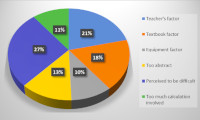Identifying the Causes of Low Student Enrolment in STEM Courses in Nigerian Higher Educational Institutions
Keywords:
Policy, Education, STEM, HEIsAbstract
Because of students' poor engagement in science, the government's Higher Educational Institution (HEI) admission policy of a 60:40 science/arts ratio at Nigeria's Higher Educational Institutions (HEIs) has been unable to fully implement the programme. According to this interpretation, an economy cannot grow its human and material resources if it does not have a sufficient pool of suitably skilled workers in research and scientific-related sectors at all levels of government. For the foreseeable future, the STEM workforce will continue to be critical to our economic vitality, with contributions to innovation, technological growth, and economic development expected. As part of the effort to determine the root cause of this lack of interest, this research was conducted. After asking themselves why STEM-related courses were not offered at higher education institutions, students responded with six broad distinct groupings that might be classified as follows: According to the findings of the survey, the notion that STEM courses are difficult is the most significant factor preventing students from enrolling in STEM-related courses in college. When it comes to dealing with the issues that have been recognised. The government would have to play a key role in driving the process by putting in place policies that are viable and implementable.
References
Abdullahi, N., J.K. and A.A.G. Jimoh, 2018. Head teachers’ role in managing science education towards sustainable development in North- central zone, Nigeria. Malaysian Online Journal of Educational Sciences, 6(3): 20-29. View at Google Scholar
Abdulraman, M.S. (1992). Placement in higher and tertiary education: progress and prospects. In B. Ipaye (Ed). Education in Nigeria: past, present and future. Ibadan: Macmillan Nigerian publishers Ltd, 91-112.
Adesoji, F.A., 2018. National and global trend on stem education and economic development. Advances in Social Sciences Research Journal, 5(6): 143-146. View at Google Scholar | View at Publisher
Aina, J.K. and G.A. Adedo, 2013. Perceived causes of students’ low enrolment in science in secondary schools, Nigeria. International Journal of Secondary Education, 1(5): 18-22. View at Google Scholar. View at Publisher
Aina, J.K and Akanbi, A.G (2013). Perceived Causes of Students’ Low Enrolment in Science in Secondary Schools, Nigeria. International Journal of Secondary Education. Vol. 1, No. 5, 2013, pp. 18-22. doi: 10.11648/j.ijsedu.20130105.11
Akanbi, A.O (2003). An Investigation into Students’ Performance in Senior Secondary School Physics. Journal of Teacher education trends, Vol. 1(1), 2003, pp. 58- 64.
Aragon, S., 2016. Teacher shortages: What we know. Teacher shortage series. Education Commission of the States. Broadway Suite: ERIC. Retrieved from http://www.ecs.org [Accessed August 20, 2018].
Bamidele, L (2004). Students’ Poor Performance in Physics. A Bane to our Nation’s Technological Development. Nigerian Journal of Science Education and Practice. Vol. 2(1), 2004, pp. 174-179
Carnevale, A.P., Smith, N and Melton, M (2018). Science Technology Engineering Mathematics (STEM). Georgetown University Center on Education and the Workforce forecast of occupational growth, 2018.
Forni, A.P., 2007. Shortage of qualifed science teachers in Norway. A system dynamics approach. (Master's Thesis, The University of Bergen).
Gonzalez, H.B and Kuenzi, J.J ( 2012). Congressional Research Service – CRS:. Science, Technology, Engineering, and Mathematics (STEM) Education: A Primer. August 1.
Hidayah M F and Rohaida M S 2014 Eurasia J. of Mathematics, Science & Technology Education 10 209
Maduabum, M.A. (2000). Gender disparity in science, technology and mathematics (STM) university education: Nigeria in international perspectives. Journal of Educational studies, 6, 25 - 28.
Mangrubang, F.R., 2005. Issues and trends in science education: The shortage of qualified science teachers. American Annals of the Deaf, 150(1): 42-46. View at Google Scholar | View at Publisher
Milaturrahmah, N., Mardiyana, M and Pramudya, I. (2017). Mathematics Learning Process with Science, Technology, Engineering, Mathematics (STEM) Approach in Indonesia. International Conference on Mathematics and Science Education (ICMScE) IOP Publishing IOP Conf. Series: Journal of Physics: Conf. Series 895 (2017) 012030 doi :10.1088/1742-6596/895/1/012030
Obiadazie, C.S (2016). Poor enrolment of senior secondary students in science: a case study of onitsha education zone. International Journal of Research in Education. Vol. 1. No. 1 December, ISSN 2141 825X www.oasisinternationaljournal.org
Okoroma, N.S (2006). Educational policies and problems of implementation in Nigeria. Australian Journal of Adult Learning Volume 46, Number 2, July 2006
Okoroma, N.S. (2000). The perspectives of educational management, planning and policy analysis, Port Harcourt: Minson Publishers.
Osokoya, O.I. (1987). 6-3-3-4 education in Nigeria: history, strategies, issues and problems, Lagos: Bininaike Educational Publishers.
Panjwani, N., 2018. Motivation: An integral part towards job satisfaction among nurses. International Journal of Science and Research Methodology, 9(2): 23- 38.
Subair, S.T. and R.B. Talabi, 2015. Teacher shortage in Nigerian schools: Causes, effects administrators coping strategies. Asia Pacific Journal of Education, Arts and Sciences, 2(4): 31-37. View at Google Scholar
Thomasian, J (2011). Building a Science, Technology, Engineering and Math Education Agenda. Black Point Policy Solutions, LLC NGA Center for Best Practices. December.




